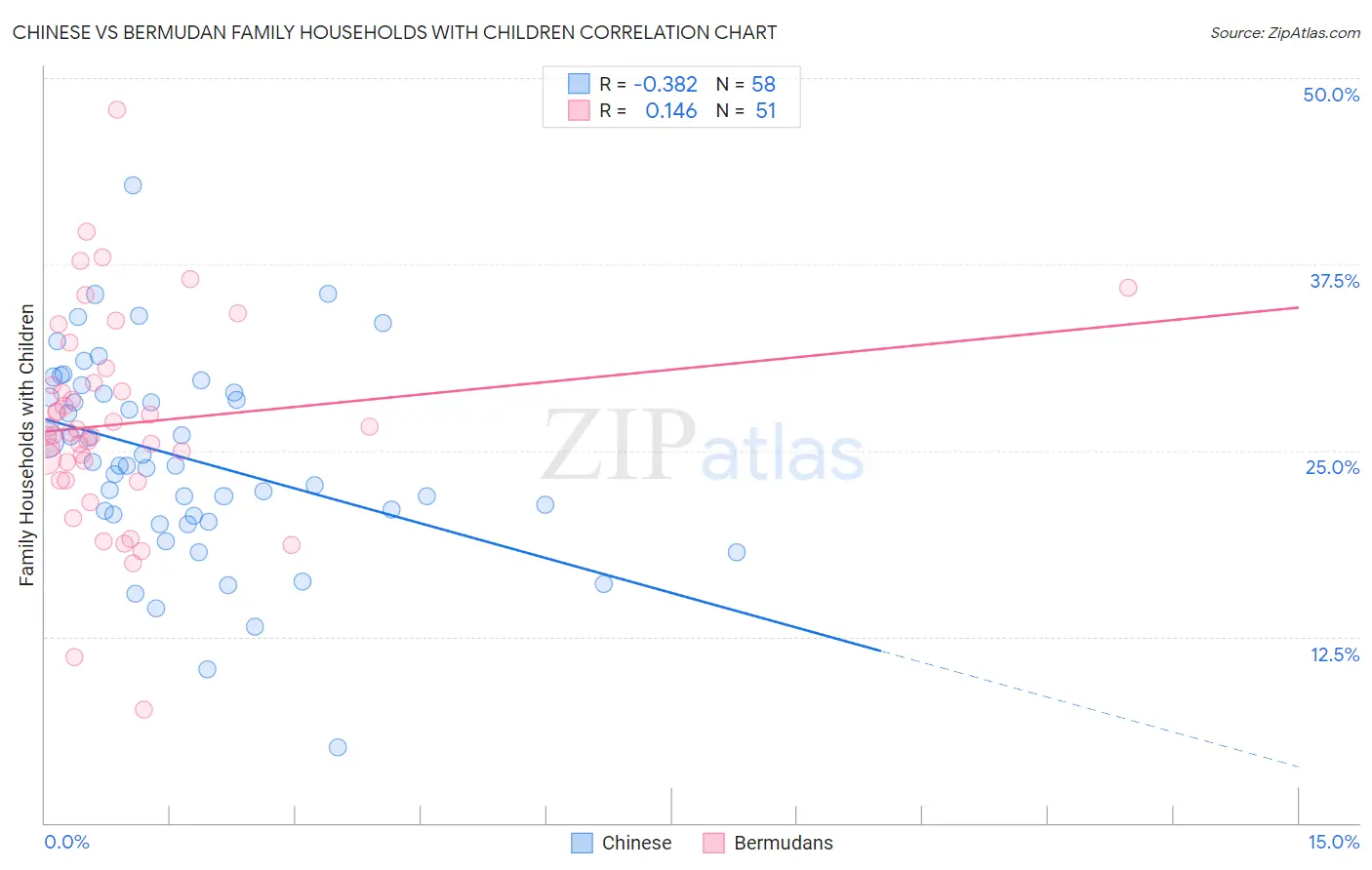Chinese vs Bermudan Family Households with Children
COMPARE
Chinese
Bermudan
Family Households with Children
Family Households with Children Comparison
Chinese
Bermudans
26.0%
FAMILY HOUSEHOLDS WITH CHILDREN
0.0/ 100
METRIC RATING
324th/ 347
METRIC RANK
26.3%
FAMILY HOUSEHOLDS WITH CHILDREN
0.1/ 100
METRIC RATING
306th/ 347
METRIC RANK
Chinese vs Bermudan Family Households with Children Correlation Chart
The statistical analysis conducted on geographies consisting of 64,800,060 people shows a mild negative correlation between the proportion of Chinese and percentage of family households with children in the United States with a correlation coefficient (R) of -0.382 and weighted average of 26.0%. Similarly, the statistical analysis conducted on geographies consisting of 55,716,155 people shows a poor positive correlation between the proportion of Bermudans and percentage of family households with children in the United States with a correlation coefficient (R) of 0.146 and weighted average of 26.3%, a difference of 1.2%.

Family Households with Children Correlation Summary
| Measurement | Chinese | Bermudan |
| Minimum | 5.1% | 7.6% |
| Maximum | 42.8% | 47.9% |
| Range | 37.7% | 40.3% |
| Mean | 24.4% | 26.8% |
| Median | 24.0% | 26.2% |
| Interquartile 25% (IQ1) | 20.6% | 23.0% |
| Interquartile 75% (IQ3) | 28.8% | 29.6% |
| Interquartile Range (IQR) | 8.2% | 6.5% |
| Standard Deviation (Sample) | 6.8% | 7.1% |
| Standard Deviation (Population) | 6.7% | 7.0% |
Demographics Similar to Chinese and Bermudans by Family Households with Children
In terms of family households with children, the demographic groups most similar to Chinese are Immigrants from Australia (26.0%, a difference of 0.030%), Barbadian (26.0%, a difference of 0.060%), Immigrants from Greece (26.0%, a difference of 0.070%), British West Indian (26.0%, a difference of 0.080%), and Tlingit-Haida (26.0%, a difference of 0.090%). Similarly, the demographic groups most similar to Bermudans are Guyanese (26.3%, a difference of 0.010%), West Indian (26.3%, a difference of 0.080%), Lumbee (26.3%, a difference of 0.10%), Immigrants from Somalia (26.3%, a difference of 0.21%), and Marshallese (26.2%, a difference of 0.26%).
| Demographics | Rating | Rank | Family Households with Children |
| Guyanese | 0.1 /100 | #305 | Tragic 26.3% |
| Bermudans | 0.1 /100 | #306 | Tragic 26.3% |
| West Indians | 0.0 /100 | #307 | Tragic 26.3% |
| Lumbee | 0.0 /100 | #308 | Tragic 26.3% |
| Immigrants | Somalia | 0.0 /100 | #309 | Tragic 26.3% |
| Marshallese | 0.0 /100 | #310 | Tragic 26.2% |
| Colville | 0.0 /100 | #311 | Tragic 26.2% |
| Immigrants | Czechoslovakia | 0.0 /100 | #312 | Tragic 26.2% |
| Cree | 0.0 /100 | #313 | Tragic 26.2% |
| French Canadians | 0.0 /100 | #314 | Tragic 26.1% |
| Immigrants | Norway | 0.0 /100 | #315 | Tragic 26.1% |
| Estonians | 0.0 /100 | #316 | Tragic 26.1% |
| Ottawa | 0.0 /100 | #317 | Tragic 26.1% |
| Iroquois | 0.0 /100 | #318 | Tragic 26.1% |
| Immigrants | France | 0.0 /100 | #319 | Tragic 26.0% |
| Tlingit-Haida | 0.0 /100 | #320 | Tragic 26.0% |
| British West Indians | 0.0 /100 | #321 | Tragic 26.0% |
| Immigrants | Greece | 0.0 /100 | #322 | Tragic 26.0% |
| Immigrants | Australia | 0.0 /100 | #323 | Tragic 26.0% |
| Chinese | 0.0 /100 | #324 | Tragic 26.0% |
| Barbadians | 0.0 /100 | #325 | Tragic 26.0% |